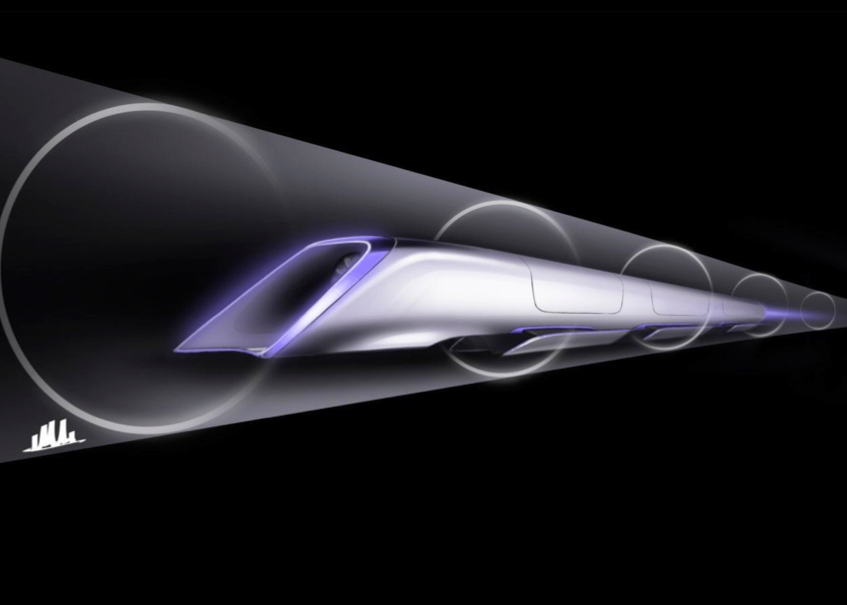A test track for the Hyperloop high-speed transportation network – first conceived by entrepreneur Elon Musk – will begin work in California next month (+ slideshow).
A full-sized prototype of the system, which would see passengers propelled in capsules at speeds of up to 760 miles per hour through a network of tunnels, is due to be built in California.
"It is the closest thing to teletransportation," Hyperloop's chief operating officer Bibop Gabriele Gresta told Dezeen during an event titled Transport to the Future in London last night.
"It will change completely humanity," he added.
According to Gresta, work will begin on the $150 million (£98 million) test track in the next two to three weeks. Covering a five-mile stretch in Quay Valley – a proposed solar-powered city in Kings County, California – the prototype will take 32 months to complete and will transport 10 million passengers over the duration of its testing process.
Passengers will travel in computer-automated capsules, drawn by powerful vacuums and magnets, through an elevated tube at speeds of up to 160 miles per hour.
Empty capsules will be tested at its full potential of 760 miles per hour – close to the speed of sound. "We will crush every record on the ground," said Gresta.
Elon Musk, the founder of electric car company Tesla Motors, Paypal and the space exploration company SpaceX, first unveiled the concept for Hyperloop in 2013. The initial scheme proposed covering a 400-mile route between Los Angeles and San Francisco in 30 minutes, providing a quicker and cheaper alternative to road, rail and air travel in the future.
"You can substitute the entire flight industry from Los Angeles to San Francisco with one tube, four times," added Gresta. "Now if this will not disrupt the air industry I don't know what will."
While the prototype will be located along part of the proposed Los Angeles and San Francisco route, Gresta believes that the first full Hyperloop system will not be built in America.
"There are other countries that are in a more advanced discussion phase and they have the political will, the lack of infrastructure, a high density of population and less regulatory problems to make it happen," he said.
The system is designed to be earthquake and weather resistant, with each pylon capable of supporting seven passenger Hyperloop tubes and one for security purposes – transporting an estimated 3,400 passengers per hour, and 24 million people each year.
Gresta suggested that future hyper stations might be reached by self-driving cars, like the model proposed by Google, to make the journey fully autonomous.
The use of straight tubes to host the pods is intended to help minimise the g-force experienced by passengers – expected to range between 1-5g, similar to that experienced by a Formula One race driver. "It's a lot but it doesn't kill you," said Gresta.
The service will be powered by renewable energy, with a surplus of solar, wind and kinetic power sold back to the grid to make the service profitable.
"It will consume less electricity than we produce. We can resell electricity," said Gresta. "In this model it will allow us to recoup the entire investment in six to eight years depending on where you build it."
"We're able to do something that is not subsidised by the state. This is super important because 100 per cent of high-speed rail in the planet is subsidised by the state."
The world's longest billboard will be erected alongside the test track, helping to finance the project and making travel free for passengers. The final version will have no windows – instead a series of screens could surround the capsule, providing in-journey entertainment for passengers.
Gresta envisages that pods could be dedicated to patient and organ transport or sold to private companies such as Disney at a cost of $2 million (£1.3 million).
While Gresta says Elon Musk is supportive of the company, the entrepreneur is not directly involved in its day-to-day operation because he "is too busy with Tesla, SpaceX and SolarCity and he has his own problems".
Hyperloop has plans to roll the transport system out globally, and says a route from London to Glasgow could cost between $6 billion (£3.9 billion) and $8 billion (£5.2 billion) to construct. At just 30 minutes, the journey time could help passengers "regain their lives" through time saved in traffic jams or waiting at airports.
The Transport to the Future event took place in London's King's Cross and was organised by workflow app BaseStone as part of its Construct//Disrupt series on disruptive technologies in engineering and construction.
This article has been updated. The original amount quoted by Hyperloop for the test track has been amended from $6 billion (£3.9 billion) to $150 million (£98 million).












